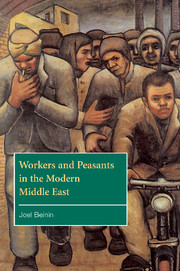Book contents
- Frontmatter
- Contents
- List of tables
- Acknowledgments
- Glossary
- List of acronyms and abbreviations
- Map 1: The Ottoman Empire, 1699–1914
- Map 2: Egypt and Bilad al-Sham
- Map 3: The Middle East in the twentieth century
- Introduction
- 1 The world capitalist market, provincial regimes, and local producers, 1750–1839
- 2 Ottoman reform and European imperialism, 1839–1907
- 3 The rise of mass politics, 1908–1939
- 4 Fikri al-Khuli's journey to al-Mahalla al-Kubra
- 5 Populist nationalism, state-led development, and authoritarian regimes, 1939–1973
- 6 Post-populist reformation of the working class and peasantry
- Notes
- References
- Index
6 - Post-populist reformation of the working class and peasantry
Published online by Cambridge University Press: 03 February 2010
- Frontmatter
- Contents
- List of tables
- Acknowledgments
- Glossary
- List of acronyms and abbreviations
- Map 1: The Ottoman Empire, 1699–1914
- Map 2: Egypt and Bilad al-Sham
- Map 3: The Middle East in the twentieth century
- Introduction
- 1 The world capitalist market, provincial regimes, and local producers, 1750–1839
- 2 Ottoman reform and European imperialism, 1839–1907
- 3 The rise of mass politics, 1908–1939
- 4 Fikri al-Khuli's journey to al-Mahalla al-Kubra
- 5 Populist nationalism, state-led development, and authoritarian regimes, 1939–1973
- 6 Post-populist reformation of the working class and peasantry
- Notes
- References
- Index
Summary
Since the early 1970s, the working class and the peasantry of the Middle East have been socially reorganized. Simultaneously, their political salience has been discursively reconfigured. These processes are associated with the abandonment of state-led, import-substitution industrialization and other forms of economic nationalism and populist social policies of the previous period. Middle Eastern states fitfully adopted a new orientation towards reintegration into the world economy, encouragement of private enterprise, rollback of agrarian reform, and upward redistribution of national income. The timing, motivation, extent, and consequences of these transitions varied. But the trend across the region, and throughout Asia, Africa, and Latin America, is indisputable.
Tunisia was the first country to turn away from statist development, symbolized by the ouster of Ahmad Ben Salah as minister of national economy in 1969. Egypt began to retreat from Arab socialism in March 1968, even before Gamal ʿAbd al-Nasir's death, although the ideological elaboration of the new orientation did not occur until 1974. The 1980 military coup in Turkey brought to power a regime committed to neoliberal economic policies. Oil wealth enabled Algeria to avoid facing the contradictions of import-substitution industrialization in the 1970s and to attempt to address them on its own terms at the end of the decade. The specificities of these cases suggest that monocausal or globalist explanations for the demise of state-led development policies – the theory linking these economic changes to the transition from authoritarian-populism to bureaucratic-authoritarianism (O'Donnell 1978), interpretations stressing pressures from the United States and Great Britain during the Reagan–Thatcher era as part of an effort to roll back economic nationalism (Bello 1994), or the all-pervasive power of the International Monetary Fund (IMF) and the World Bank (Abdel-Khalek 1981 a; Amin 1995; Niblock 1993) – must be modified by the particularities of each case.
- Type
- Chapter
- Information
- Workers and Peasants in the Modern Middle East , pp. 142 - 169Publisher: Cambridge University PressPrint publication year: 2001
- 1
- Cited by

